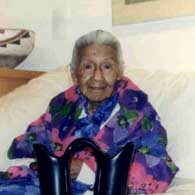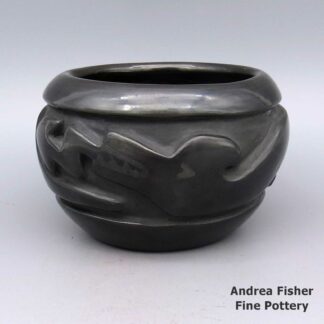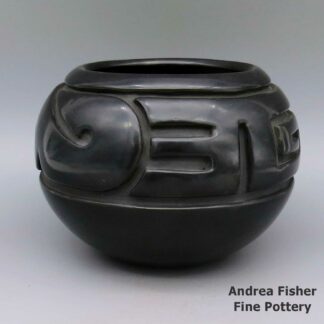Tafoya, Margaret

“Excellence was the operative word. She raised the bar so high and required the next generation to rise to that level.” – Nancy Youngblood speaking of her grandmother, Margaret Tafoya
Maria Margarita “Margaret” Tafoya, given the Tewa name Gia-Khun-Povi, (meaning: Corn Blossom), unintentionally became the matriarch of Santa Clara Pueblo potters. Born in 1904 she learned the traditional art of pottery making from her mother, Sara Fina Tafoya. Her potting style was also influenced by her older sister Tomasita and by her paternal aunt, Santana Tafoya Gutierrez.
Born in Santa Clara Pueblo near Santa Fe, New Mexico, Margaret attended elementary school on the pueblo. When she wasn’t in school she could usually be found making pottery. As a young girl she would accompany her parents, Sara Fina and Geronimo Tafoya, on clay-digging trips, taking picnics and traveling by horse and buggy. Later she attended Santa Fe Indian School as a boarding student from 1915 until 1918. That separated her from the clay for most of the year as she was only home in the summers. When her sister Tomasita died during the flu epidemic of 1918, Margaret returned home to stay with her mother.
Margaret had grown up under her mother’s watchful eye, learning and slowly gaining more responsibility in regards to the clay. Finally, Margaret’s work was as good as her mother’s. That’s when she married Alcario Tafoya: 1924.
Alcario was a painter and a wood carver. Margaret and Sarafina added his skills to their repertoire and together, they set the bar for Santa Clara pottery very high.
Margaret’s name started to spread when Fred Harvey Detours started making trips by automobile to the pueblos from Santa Fe’s La Fonda Hotel. Her reputation picked up further through continued participation in the Santa Fe Indian Market, the Fiestas de Santa Fe, the Gallup InterTribal Ceremonial and the New Mexico State Fair.
Margaret originally created traditional utilitarian red and black vessels. Following the ancient method of coil-building her pottery with clay taken only from the grounds of Santa Clara Pueblo, she continued her mother’s tradition of making exceptionally large pots with finely polished surfaces and simple carved designs. Her largest pieces were up to 24 inches tall and up to 21 inches in diameter. The clay for one of those took months to prepare, days to form and polish, then meticulous care through the firing process.
Margaret’s “bear paw” motif and deeply carved pueblo symbols like the avanyu (the mythic Tewa water serpent) and kiva steps around the shoulder of her jars are now signature trademarks of Tafoya family pottery. Margaret also used her fingers to impress lines and bear paws into the clay. For deeper designs, she would draw them in pencil and Alcario would carve them. Alcario was an experienced wood carver but he wouldn’t carve anything until a vessel had dried at least overnight.
Together, Margaret and Alcario raised thirteen children, many of whom carried on the family tradition of making pottery. Her commitment to quality, precision and esthetic simplicity in her pottery has been transferred to subsequent generations of her family. Her granddaughter Nancy Youngblood remembers, “Excellence was the operative word. She raised the bar so high and required the next generation to rise to that level.”
Among the matriarchs of Pueblo pottery, Margaret Tafoya’s place is unique. She neither innovated a style like Maria Martinez, who originated black-on-black pottery at San Ildefonso Pueblo, nor revived an art form from prehistoric remains like Nampeyo of Hano at Hopi or Marie Z. Chino who perfected fine line pots at Acoma. She did, however, bind herself to the cultural traditions of Santa Clara Pueblo.
Margaret’s curiosity led her to make a few pots in the Ohkay Owingeh Potsuwi’i style. She made a few pots using creamy clay coatings and various clay and vegetal slips. She even made a few pots in Roman and Greek forms. But she always came back to the forms and designs of her Tewa ancestors, taken from samples of Ancestral Puebloan pottery dating back as far as 500 CE.
Despite changes in styles and techniques over time, Margaret held firm to her faith in the clay. As a result of that commitment, she created some of the largest, simplest and most aesthetically pleasing pieces of Pueblo pottery made in the twentieth century.
By the 1960s Margaret’s pottery had become famous. She received the Best of Show Award in 1978 and 1979 at the Santa Fe Indian Market. In 1981, the National Endowment for the Arts awarded her a National Heritage Fellowship in recognition of her accomplishments. In 1984 she was given the New Mexico Governor’s Award for Excellence in the Arts. She was also recognized and received an award as a Master Traditional Artist in 1985.
Margaret’s first exhibition was held in 1974 at the Maxwell Museum of Anthropology in Albuquerque, New Mexico. She was honored with retrospectives in 1982 at the Denver Museum of Natural History and in 1983 at the Wheelwright Museum of the American Indian in Santa Fe. In 1984, she was named Folk Artist of the Year by the National Endowment for the Arts in Washington, DC and in 1985 and 1992 received Lifetime Achievement awards.
Margaret continued making pottery at Santa Clara until her death in 2001.
Margaret’s first and only show held in a gallery was here at Andrea Fisher Fine Pottery in 1998. During the late 1960s and early 1970s, when Margaret was famous and in her prime, there were very few galleries in Santa Fe, much less one that carried Native Art. Margaret’s only sales venues were Indian Markets like the one held in Santa Fe for the last 100 years, or the inventory she sold from the brown shelves in her living room. By the time an American Indian art gallery existed, Margaret’s pottery production had slowed down. The show at Andrea Fisher Fine Pottery was a retrospective and celebration of her 94th birthday.
“Margaret’s daughter, Shirley Cactus Flower Tafoya (or Berta as she was called by her family), was Margaret’s main caretaker. Margaret’s bedroom had two single beds and on the second one, two months before the show, Margaret carefully laid out the clothes she wanted to wear to the opening. Berta and I,” said Andrea, “laughed because Margaret insisted that the clothes stay there and Berta had the job of dusting them for months.
“The day finally arrived. That morning Berta called me and said, ‘Mom is not feeling well.’ All I could think of was all of the advertising, all of the time to assemble the show material, the birthday cake and on and on and on and she would not be able to make an appearance. Two hours before the opening Berta called and said they would be there. I experienced the greatest relief of my life.
“It turns out she was not ill but so excited and extremely worried that no one would come, and WOW did they come! She was half-an-hour late for the reception and by the time she arrived, the Santa Fe Police and Fire Department had arrived, blocking the streets in the area in an effort to control traffic and the crowd of more than 2,000 people that were waiting for Margaret. This tiny little lady, on the arm of Berta, slowly parted the crowd to the whispers of ‘there she is’ and the cheers of others. It was like Moses parting the Red Sea. She was so happy, greeting everyone, posing for photographs and smiling through all the attention.
“I think there were many moments during that reception that she really enjoyed, including posing for a picture surrounded by her enormous family. She was surprised when Derek, who was 17 years old at the time, staggered under the weight of an enormous chocolate cake with ninety-four candles on it, presenting it to her while the crowd sang Happy Birthday! It is a wonder that the smoke alarm did not join in. It was an incredible evening. Margaret left the gallery hours later, happy and exhausted. Berta said she slept the entire next day. We will always remember Margaret as a lovely, charming lady who enjoyed hamming it up in front of a camera, who was extremely talented and who celebrated the pottery tradition of her heritage.”
Some Exhibits that featured works by Margaret
- Beauty Speaks for Us. Heard Museum. Phoenix, Arizona. February 10, 2017 – March 31, 2017
- Over the Edge: Fred Harvey at the Grand Canyon and in the Great Southwest. Heard Museum. Phoenix, Arizona. Opened April 9, 2016
- Something Old, Something New, Nothing Borrowed: New Acquisitions from the Heard Museum Collection. Heard Museum. Phoenix, Arizona. April 2, 2011 – March 18, 2012
- Born of Fire: The Life and Pottery of Margaret Tafoya. Carnegie Museum of Natural History. Pittsburgh, Pennsylvania. October 4, 2008 – January 9, 2009
- Choices and Change: American Indian Artists in the Southwest. Heard Museum North. Scottsdale, Arizona. June 30, 2007 – September 29, 2007
- Home: Native People in the Southwest. Heard Museum. Phoenix, Arizona. May 22, 2005- Note: Heard Museum’s ongoing, signature exhibition
- 75 Years at the Heard Museum. Heard Museum North. Scottsdale, AZ. January 29, 2005 – 2006
- Breaking the Surface: Carved Pottery Techniques and Designs. Heard Museum. Phoenix, AZ. October 2004 – October 2005
- The Collecting Passions of Dennis and Janis Lyon. Heard Museum. Phoenix, AZ. May 1, 2004 – September 1, 2004
- Masterworks by Native Peoples of the Southwest. Heard Museum. Phoenix, AZ. June 21, 2003 – June 20, 2005
- Every Picture Tells a Story. Heard Museum. Phoenix, AZ. September 20, 2002 – September 1, 2005
- Hold Everything! Masterworks of Basketry and Pottery from the Heard Museum. Heard Museum. Phoenix, AZ. November 1, 2001 – March 10, 2002
- The Legacy of Generations: Pottery by American Indian Women. Heard Museum. Phoenix, AZ. February 14, 1998 – May 17, 1998
- The Legacy of Generations: Pottery by American Indian Women. The National Museum of Women in the Arts. Washington, DC. October 9, 1997 – January 11, 1998
- Recent Acquisitions. Heard Museum. Phoenix, AZ. July 12, 1997 – January 11, 1998
- Timeless Impressions. Heard Museum. Phoenix, AZ November 12, 1994 – July 31, 1995
- The Galbraith Collection of Native American Art. Gallery of Indian Art. Heard Museum. Phoenix, AZ. October 15, 1988 – May 7, 1989
- American Indian Art: The Collecting Experience. Elvehjem Museum of Art. University of Wisconsin/Madison. Madison, WI. May 7, 1988 – July 3, 1988
- Native People of the Southwest. Heard Museum. Phoenix, Arizona. 1985 – May 2003
- Margaret Tafoya: A Potter’s Heritage and Her Legacy. Denver Museum of Natural History. Denver, CO. 1983 – January 22, 1984
- The Red and The Black: Santa Clara Pottery by Margaret Tafoya. Wheelwright Museum of the American Indian. Santa Fe, NM. June 12, 1983 – September 16, 1983
- The Santa Fe Indian Market in Perspective. Wheelwright Museum of the American Indian. Santa Fe, New Mexico. August 1979 – September 24, 1979
Showing all 2 results
-

Margaret Tafoya, mcsc2h161, Bowl with an avanyu design
$2,500.00 Add to cart -

Margaret Tafoya, zzsc2h331, Bowl carved with avanyu design
$5,200.00 Add to cart
Showing all 2 results